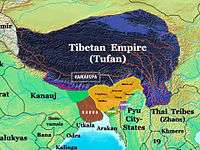Pragjyotishpura
%2C_Kamarupa_-_Panel_on_Plinth.jpg)

Pragjyotishpura (Pron: prægˈʤjəʊtɪʃˌpʊərə), now Guwahati, was capital of Kamarupa Kingdom under Varman Dynasty (350 - 650 A.D). [1]
Etymology
The word Pragjyotishpura derived from Sanskrit words "Prag", "Jyotish" and "Pur" meaning 'city of eastern light' otherwise 'city of eastern astrology'.

Archeological excavations
Due to the discovery of archaeological sites scattered around Guwahati in plenty such as Ambari, it convinced Archeologists that on digging a meter into the ground at any place in city pieces of pottery, broken stone images or beautifully polished stone blocks will be found. Dr Medhi, an anthropologist from the Gauhati University has published in one of his research papers that a civilization similar to the Indus Valley civilization flourished in the Brahmaputra Valley. He also said that archaeologists have proved the existence of the city of Pragjyotishpura which is largely said to be buried under the present day city of Guwahati. Dr. Medhi also stated that most archeologists also believed that an ancient city known as Pragjyotishpura is mentioned frequently in the Mahabharata and Ramayana and the Kalika Purana existed in Assam. The location of a temple of planet worship called Navagraha, meaning an abode of nine planets of the solar system, and its connection with an ancient research on astronomy and astrology lends weight to the origin of its name. [2]
Xuanzang's accounts
Xuanzang visited Pragjyotispura at the time of king Bhaskar Varman and stayed for few months with royal hospitality. He mentioned that climate was genial. The people were honest. Their speech differed a little from that of mid-India. They were of violent disposition but were persevering students. They worshipped the Devas as Hinduism was sole religion. The Deva-temples were some hundreds in number and the various systems had some myriads of professed adherents. The few Buddhists in the country performed their acts of devotion in secret.